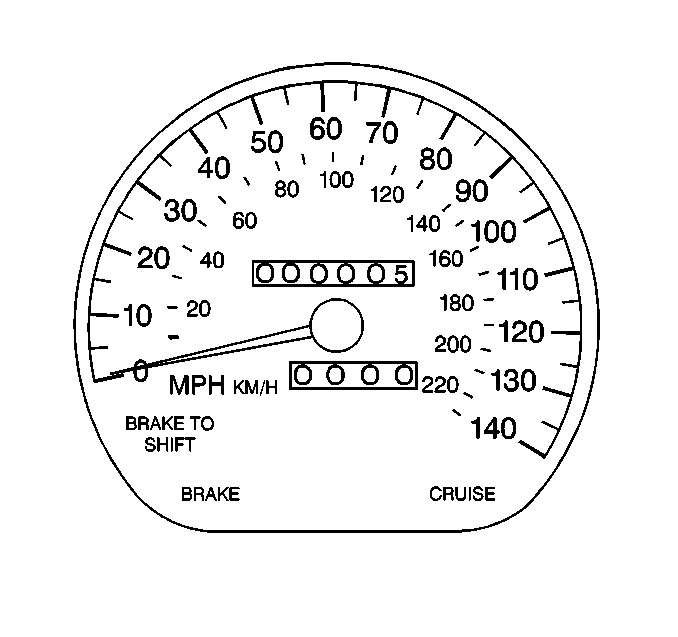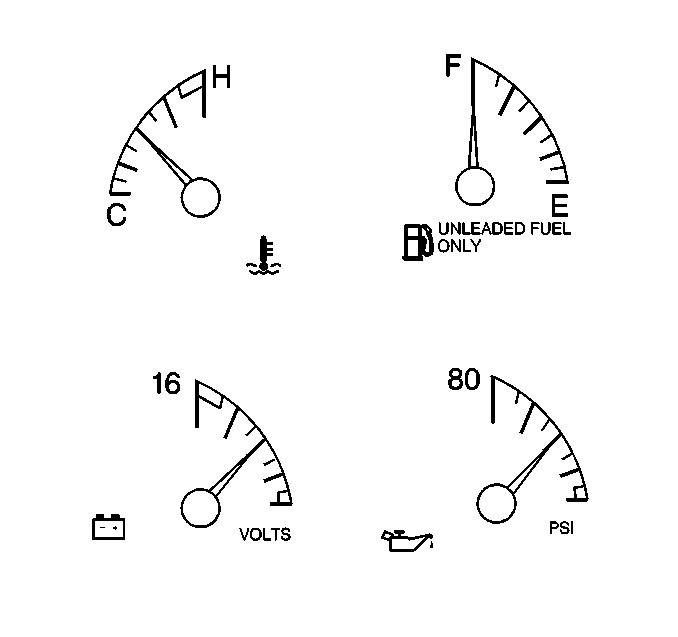Speedometer
The analog speedometer in this vehicle is controlled by a steeper motor measuring mechanism actuated by a stepper motor driver. The input to the speedometer is supplied exclusively by the Electronic Brake Traction Control Module (EBTCM). The maximum display readout range is 185 degrees of pointer sweep. With power applied to the speedometer the speedometer pointer is moved back to the internal stop for zero point recognition (restart). Without power to the speedometer the pointer is not moved back to the zero position. The speedometer display accuracy tolerance is accurate to within +/- 2.0 degrees of needle sweep.

Tachometer
The tachometer display is controlled by a stepper motor measuring mechanism actuated by a stepper motor driver. The input signal is provided by the Engine Control Module (ECM). A tachometer pulse factor is stored in the Electronically Erasable Programmable Read Only Memory (EEPROM) for conversion or the input frequency into revolutions. Range: 1.50 to 655.35 pulse/revolution, resolution: 0.01 pulse/revolutions. At a tachometer pulse factor less than 1.50 pulse/revolution, the instrument behaves as in the case of EEPROM not programmed. The maximum display angle is 115.5 degrees of pointer sweep and has a display tolerance for accuracy of +/- 2.4 degrees.

Fuel Level Gauge
The fuel level gauge circuit reads the fuel level in the gas tank through the use of a fuel tank sending unit which is mounted on the top surface of the fuel tank. The fuel tank sending unit itself consists of a float that rides on the surface of the fuel in the tank and a variable resistor controlled by the float arm. When electric power is supplied to the fuel gage, current flows through the gage to the variable resistor and then to ground. The position of the display is determined by the strength of the current flowing through the gage. The maximum display range of the pointer is 93 degrees and has a display tolerance of +/- 4.4 degrees.
As the fuel level decreases the sending unit resistance increases and when the fuel level increases sending unit resistance decreases. The display of the correct fuel level is dampened slightly upon start-up (cycling of ignition) and will stabilize after approximately 12 seconds. The sensor resistance range is from 283.00 ohms at 0 liters (tank empty) to 38.00 ohms at 62 liters (tank full).

Coolant Temperature Gauge
The coolant temperature gauge circuit reads engine coolant temperature through the use of an engine mounted coolant temperature sensor (thermistor). The voltage is sent from the fuse block through the instrument cluster to the coolant temperature sensor (thermistor) and to ground. As coolant temperature increases, thermistor resistance decreases and when coolant temperature decreases thermistor resistance increases. The display of the correct temperature reading is dampened slightly upon start-up (cycling of ignition) and will stabilize after approximately 12 seconds. The sensor resistance range is from 320.49 ohms at 50°C to 36.095 36.95 ohms at 130°C.
When the ignition is returned to the OFF position the coolant temperature gauge will return the pointer to mechanical zero position or C. If any time a coolant temperature sensor error is recognized for more than 8 seconds by the gauge the pointer will return to mechanical zero or C. If the sensor signal is then recognized as being intact for more than 4 seconds the gauge will resume operation as in a start up (cycling of ignition) mode (will take approx. 12 seconds to stabilize).
The coolant temperature gauge will provide accurate readout with operating voltage anywhere between 9 and 16 volts. The coolant temperature gauge accuracy tolerance is accurate within 4.4 degrees of needle sweep. The gauge can also tolerate a 24 volt over voltage situation for up to 60 seconds and a reverse battery voltage situation of -12 volts for 60 seconds with no lasting damage to the unit.

Oil Pressure Gauge
The oil pressure gauge indicates the pressure of the lubricating oil provided by the engine oil pump. The oil pressure gauge sending unit is a variable resistor mounted to the front of the engine so it will sense the oil pressure in a main oil passage just downstream from the engine oil pump. When electric power is supplied to the gauge current flows through the gauge to the resistor in the sending unit and then to ground. The position of the oil pressure gauge pointer is determined by the strength of the current flowing through the gauge.
When oil pressure is low the resistance of the sending unit also is low and current flow through the gauge is high. This cause the gauge indicator needle to show a low pressure reading. As oil pressure increases the resistance of the sending unit resistor also increases and current flow through the gage is reduced. Under normal conditions the oil pressure reading should be between 138 to 414 kPa (20 to 60 psi). Engine oil pressure should never fall below a reading of 28 kPa (4 psi) even at idle.

Voltage Gauge
The voltmeter is an instrument that shows the voltage of the vehicle's electrical system and indicates the ability of the charging system to keep the battery charged. The voltmeter is wired in parallel with other circuits in the vehicle.
When the engine is running the voltmeter indicates charging system voltage. If the engine is not running and the ignition switch is in the RUN or START position the voltmeter will show battery voltage. The voltmeter can be used as a first step in diagnosing many electrical problems. The battery voltage drop can be seen while the engine is cranking. After the engine is running the generator output voltage is indicated.
It is normal for the voltmeter to read between 11 to 13 volts during extended idle or just after starting. As the electrical load is increased or in stop and go driving the pointer may rotate temporarily to the bottom of the scale. A voltmeter reading continuously below 11 volts or above 16 volts indicates an electrical system problem.

